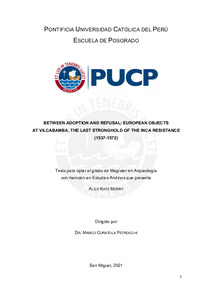| dc.contributor.advisor | Curatola Petrocchi, Marco | |
| dc.contributor.author | Merry, Alice Kate | |
| dc.date.accessioned | 2021-04-01T03:00:19Z | |
| dc.date.available | 2021-04-01T03:00:19Z | |
| dc.date.created | 2021 | |
| dc.date.issued | 2021-03-31 | es_ES |
| dc.identifier.uri | http://hdl.handle.net/20.500.12404/18722 | |
| dc.description.abstract | Vilcabamba was the site of the final stronghold of the Inca resistance for nearly forty
years from 1537 until 1572. Though it has often been thought of as an isolated region
during this period, interactions between the Inca and Spanish play an important part in its
history. This thesis explores how these interactions are reflected in the material culture of
Vilcabamba, by examining European and European-style objects at Vilcabamba,
including glass objects; scissors; other metal objects such as nails, latches, hinges and
tools; tiles; and ceramics.
These objects are analysed on the basis of both archaeological and historical evidence,
including documentation of explorations and excavations conducted at Vilcabamba, from
Hiram Bingham’s first explorations of the site in 1911 to recent excavations conducted
from 2008 to 2010 by Javier Fonseca Santa Cruz and by Brian S. Bauer and Miriam Aráoz
Silva, as well as the chronicles of Antonio Bautista de Salazar (1867 [1596]), Martín de
Murúa (2008 [ca. 1616]), Baltasar de Ocampo Conejeros (2013 [1611]), and Diego
Rodríguez de Figueroa (1910 [1565]).
From a Spanish perspective, European objects brought to Vilcabamba represented careful
gift-giving as part of delicate diplomatic negotiations. On the Inca side, selected European
objects were actively adopted and incorporated into the most important elite and ritual
settings at Vilcabamba. This thesis argues that these objects were used to create new
cultural phenomena that spoke to the strategies and ideologies of the Inca at Vilcabamba. | es_ES |
| dc.description.abstract | Vilcabamba fue el sitio del último bastión de la resistencia Inca durante casi cuarenta
años, desde 1537 hasta 1572. Aunque a menudo se ha considerado una región aislada
durante este período, las interacciones entre los incas y los españoles juegan un rol
importante en su historia. Esta tesis explora cómo estas interacciones se reflejan en la
cultura material de Vilcabamba, al examinar objetos europeos y de estilo europeo en
Vilcabamba, incluidos los objetos de vidrio; tijeras; otros objetos metálicos, como clavos,
pestillos, bisagras y herramientas; tejas; y cerámica.
Estos objetos se analizan sobre la base de evidencia arqueológica e histórica, incluida la
documentación de las exploraciones y excavaciones realizadas en Vilcabamba, desde las
primeras exploraciones del sitio por Hiram Bingham en 1911 hasta las excavaciones
recientes realizadas entre 2008 y 2010 por Javier Fonseca Santa Cruz y por Brian S. Bauer
y Miriam Aráoz Silva, así como las crónicas de Antonio Bautista de Salazar (1867
[1596]), Martín de Murúa (2008 [ca. 1616]), Baltasar de Ocampo Conejeros (2013
[1611]) y Diego Rodríguez de Figueroa (1910 [1565]).
Desde una perspectiva española, los objetos europeos llevados a Vilcabamba
representaron una cuidadosa entrega de obsequios como parte de delicadas negociaciones
diplomáticas. Del lado Inca, ciertos objetos europeos seleccionados fueron adoptados
activamente e incorporados a los espacios rituales y de élite más importantes de
Vilcabamba. Esta tesis sostiene que estos objetos fueron utilizados para crear nuevos
fenómenos culturales que se relacionaron con las estrategias e ideologías de los Incas en
Vilcabamba. | es_ES |
| dc.language.iso | spa | es_ES |
| dc.publisher | Pontificia Universidad Católica del Perú | es_ES |
| dc.rights | info:eu-repo/semantics/openAccess | es_ES |
| dc.rights.uri | http://creativecommons.org/licenses/by-nc-sa/2.5/pe/ | * |
| dc.rights.uri | http://creativecommons.org/licenses/by-nc-sa/2.5/pe/ | * |
| dc.subject | Excavaciones (Arqueología)--Perú--Cuzco--Vilcabamba | es_ES |
| dc.subject | Perú--Historia--Descubrimiento y conquista | es_ES |
| dc.subject | Vilcabamba (Cuzco : Distrito)--Restos arqueológicos | es_ES |
| dc.subject | Perú--Restos arqueológicos--Influencia española | es_ES |
| dc.title | Between adoption and refusal : european objects at Vilcabamba, the last stronghold of the inca resistance (1537-1572) | es_ES |
| dc.type | info:eu-repo/semantics/masterThesis | es_ES |
| thesis.degree.name | Magíster en Arqueología con mención en Estudios Andinos | es_ES |
| thesis.degree.level | Maestría | es_ES |
| thesis.degree.grantor | Pontificia Universidad Católica del Perú. Escuela de Posgrado | es_ES |
| thesis.degree.discipline | Arqueología con mención en Estudios Andinos | es_ES |
| renati.advisor.cext | 000219153 | |
| renati.advisor.orcid | https://orcid.org/0000-0003-3773-6823 | es_ES |
| renati.author.pasaporte | 209467332 | |
| renati.discipline | 222067 | es_ES |
| renati.juror | Watson Jimenez, Lucia Clarisa | |
| renati.juror | Curatola Petrocchi, Marco | |
| renati.juror | Artzi , Bat-Ami | |
| renati.level | https://purl.org/pe-repo/renati/level#maestro | es_ES |
| renati.type | http://purl.org/pe-repo/renati/type#tesis | es_ES |
| dc.publisher.country | PE | es_ES |
| dc.subject.ocde | http://purl.org/pe-repo/ocde/ford#6.01.02 | es_ES |






